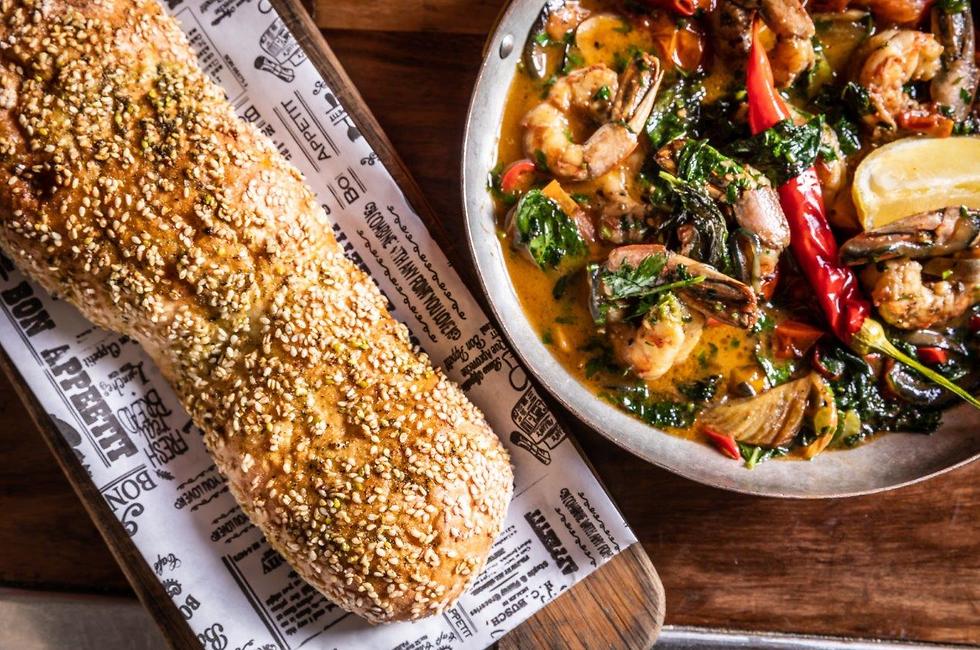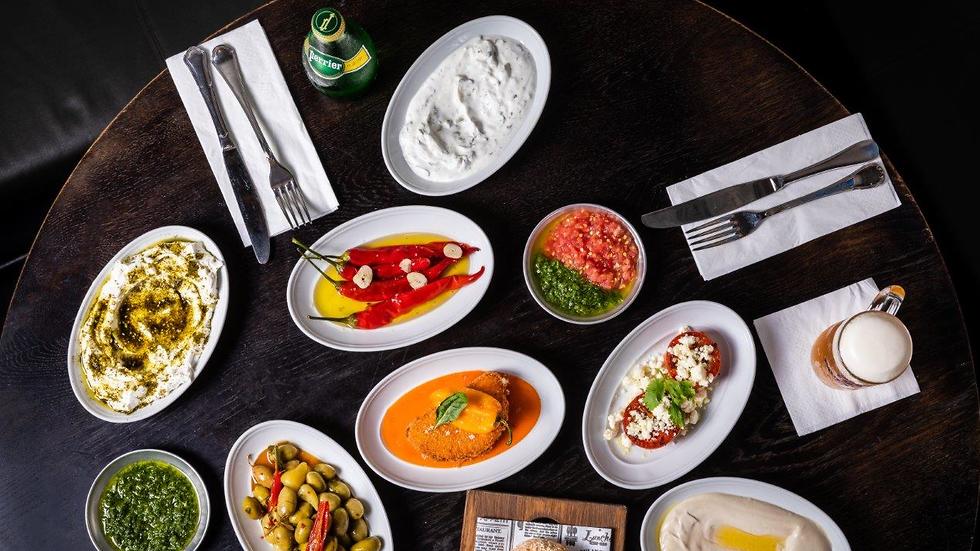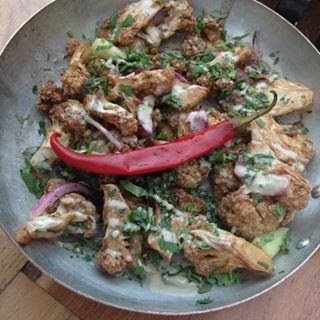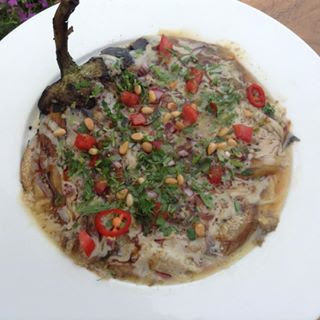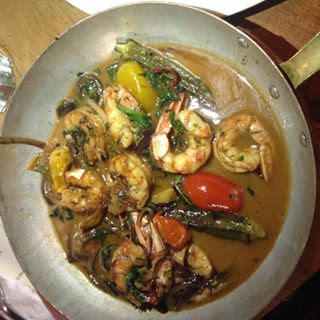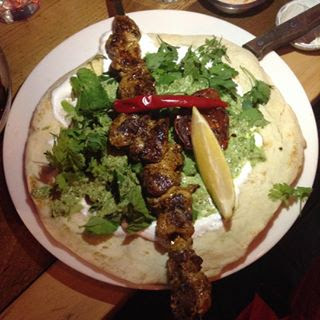
Sunday roast typically consists of roast beef, roast potatoes, other vegetables and Yorkshire pudding.
The Sunday roast is a traditional British main meal that is typically served on Sunday (hence the name), consisting of roasted meat, roast potato, and accompaniments such as Yorkshire pudding, stuffing, vegetables and gravy. Vegetables such as roast parsnips, Brussels sprouts, peas, carrots, runner beans, and broccoli are included and can be cooked in different styles; for example, cauliflower or leeks accompanied by a cheddar cheese sauce are popular, in addition to gravy. The Sunday roast is also popular in many parts of Ireland, especially in most of Ulster (chiefly in Northern Ireland and County Donegal).
Its prominence in British culture is such that in a UK poll it was ranked second in a list of things people love about Britain.[1] Other names for this meal are Sunday dinner, Sunday lunch, roast dinner, and Sunday joint (jointreferring specifically to the joint of meat). The meal is often comparable to a less grand version of a traditional Christmas dinner.
Besides being served in its original homelands, the tradition of a Sunday dinner has been a major influence on food cultures in the English-speaking world. Roast dinner is also a traditionally popular dish in the Republic of Ireland.[2] An Irish Sunday roast normally comprises roast beef or chicken, potatoes (mashed and/or roast), carrots, green vegetables (such as peas, beans, or Brussels sprouts), and gravy. In South Africa it is also common to have rice with a Sunday Roast.
Origin
The Sunday Roast originated in England as a meal to be eaten after church on Sunday. Eating a large meal following church services is common to all of the continent of Europe as with other Christian countries, but the Sunday Roast variant of this meal is uniquely English. On Sundays, all types of meat and dairy produce are allowed to be eaten, unlike on Fridays where many Roman Catholics and Anglicans traditionally abstain from eating meats, so ate fish instead. Likewise, it is traditional for Anglicans and English Catholics to fast before Sunday services, with a larger meal to break the fast afterwards. These religious rules created several traditional dishes in the United Kingdom.
Only eating fish on Friday resulted in a British tradition of 'fish Fridays' which is still common in fish and chip shops and restaurants across the United Kingdom on Fridays, particularly during Lent.
Fasting before church in Britain and the 'breaking' of that 'fast' afterwards created the British tradition of breakfast which later evolved into the full breakfast
To mark the end of not being able to eat meat the Sunday Roast was created as a mark of celebration.
There are two historical points on the origins of the modern Sunday roast. In the late 1700s during the industrial revolution in the United Kingdom, families would place a cut of meat into the oven as they got ready for church. They would then add in vegetables such as potatoes, turnips and parsnips before going to church on a Sunday morning. When they returned from the church the dinner was all but ready. The juices from the meat and vegetables were used to make a stock or gravy to pour on top of the dinner. The second opinion holds that the Sunday roast dates back to medieval times, when the village serfs served the squire for six days a week. Then, on the Sunday, after the morning church service, serfs would assemble in a field and practise their battle techniques and were rewarded with a feast of oxen roasted on a spit.
Typical elements
Meat[
Another Sunday roast with roast lamb, roast potatoes, carrots, green beans and Yorkshire pudding.
Another Sunday roast with roast beef ribs, roast potatoes, various vegetables and Yorkshire pudding.
Typical meats used for a Sunday roast are chicken, lamb, pork or roast beef, although seasonally duck, goose, gammon, turkey or (rarely) other game birds may be used.
Vegetables
Sunday roasts can be served with a range of boiled, steamed and/or roasted vegetables. The vegetables served vary seasonally and regionally, but will usually include roast potatoes, roasted in meat dripping or vegetable oil, and also gravymade from juices released by the roasting meat, perhaps supplemented by one or more stock cubes, gravy browning/thickening, roux or corn flour.
The potatoes can be cooked around the meat itself, absorbing the juices and fat directly (as in a traditional Cornish under-roast). However, many cooks prefer to cook the potatoes and the Yorkshire pudding in a hotter oven than that used for the joint and so remove the meat beforehand to rest and "settle" in a warm place.
Other vegetable dishes served with roast dinner can include mashed swede or turnip, roast parsnip, boiled or steamed cabbage, broccoli, green beans and boiled carrots and peas. It is also not uncommon for leftover composite vegetable dishes—such as cauliflower cheese and stewed red cabbage—to be served alongside the more usual assortment of plainly cooked seasonal vegetables.
Accompaniments
Common traditional accompaniments include:
Beef: Yorkshire pudding, suet pudding; English mustard, or horseradish sauce.
Pork: crackling and sage-and-onion stuffing; apple sauce or English mustard.
Lamb: mint sauce or jelly or redcurrant jelly.
Chicken: pigs in blankets, sausages or sausage meat, stuffing, bread sauce, apple sauce, cranberry sauce or redcurrant jelly.
RECIPES FOR TRADITIONAL SUNDAY ROAST
Serves 8
In many corners of the world, families gather for their own ritualized and culturally specific version of the Sunday roast—an old-fashioned meal, traditionally served in the afternoon and based on an important cut of meat (or a whole fowl), and typically accompanied by assorted vegetables. Roasts can be lean, so we add enough beef fat to the pan to give us plenty of drippings. NOTE: You'll need to prepare the batter for the puddings the day before.
**FOR THE YORKSHIRE PUDDINGS:
1 cup flour
1⁄2 tsp. salt
2 eggs, lightly beaten
1 cup milk
**
**FOR THE ROAST BEEF AND GRAVY:
1 8-12-lb. rib roast of beef
4-oz. piece beef fat
Salt and freshly ground black pepper
2 tbsp. flour
1 1⁄2 cups red wine
**
**FOR THE ROASTED VEGETABLES:
4 lbs. russet potatoes, peeled and quartered
1 1⁄2 lbs. small carrots, peeled and trimmed
1 1⁄2 lbs. parsnips, peeled, trimmed, and quartered
lengthwise
Salt
1 cup flour
Freshly ground black pepper
**
**FOR THE HORSERADISH CREAM:
1 cup heavy cream
1⁄4 cup prepared horseradish
1 tsp. white wine vinegar
Salt and freshly ground white pepper
**
**FOR THE BRUSSELS SPROUTS:
3 lbs. brussels sprouts, trimmed
Salt
3 tbsp. butter
**
1. For the yorkshire puddings: Sift together flour and salt into a mixing bowl. Add eggs and milk to flour, whisking constantly, until batter is smooth. Cover with plastic wrap and refrigerate overnight.
2. For the roast beef and gravy: Preheat oven to 325°. Put beef, meaty side up, and beef fat into a heavy-bottomed roasting pan and generously season with salt and pepper. Roast meat until internal temperature reaches 120° for rare, 130-135° for medium rare, and 140° for medium, 3-4 1/2 hours.
3. For the roasted vegetables: Put potatoes, carrots, and parsnips into a large pot of cold salted water and bring to a boil over high heat. Reduce heat to medium and parboil vegetables, about 10 minutes. Drain, reserving 1 1/2 cups of the cooking water, and set both aside. (Vegetables may be cooked up to 1 hour ahead.)
4. For the horseradish cream: Whisk cream in a medium bowl until medium-soft peaks form. Fold in horseradish and vinegar, then season to taste with salt and pepper. Transfer to a serving bowl and refrigerate until ready to use. (Cream may be made up to 1 hour ahead.)
5. Transfer roast to a warm serving platter or a carving board and loosely cover with foil. Increase oven temperature to 450°. Discard rendered piece of beef fat, then pour off all but about 3 tbsp. of the pan drippings into a bowl. Set pan and bowl aside.
6. To finish the roasted vegetables, put about 1/2 cup of the reserved drippings from the bowl into another large roasting pan and put into oven until fat is hot. Meanwhile, put flour and salt and pepper to taste into a large, wide bowl. Dredge potatoes, carrots, and parsnips in seasoned flour, shaking off excess. Remove pan from oven, add flour-coated vegetables, and turn to coat in the fat. Return pan to oven and roast vegetables, turning several times, until golden, 30-45 minutes.
7. To finish the yorkshire puddings, put about 1 tsp. of the reserved drippings from the bowl into each mold of two 4-mold yorkshire pudding tins or about 1/4 cup of the drippings into a large baking dish and put into oven until hot. Stir prepared batter until smooth, then pour into hot molds or dish and immediately return to oven. Bake until puffed and golden brown, about 30 minutes.
8. To make the gravy, put the reserved pan with the drippings on top of stove and heat over medium heat until hot. Add flour and cook, stirring constantly, until lightly browned, about 1 minute. Add wine and cook, scraping up any browned bits, until reduced by half, about 8 minutes. Add the reserved vegetable cooking water and cook for 3-4 minutes more. Stir in any meat juices accumulated from platter and season to taste with salt and pepper. Keep warm over low heat.
9. For the brussels sprouts: Put brussels sprouts into a medium pot of cold salted water and bring to a boil over high heat. Reduce heat to medium and cook until just soft, about 10 minutes. Drain, return to pot, and cover to keep warm.
10. For the peas: Bring a medium pot of salted water to a boil over high heat. Add peas and cook until soft, 3-8 minutes. Drain, return to pot, and cover to keep warm.
11. To serve the Sunday roast, transfer roasted vegetables to a warm serving platter. Unmold yorkshire puddings or cut into large pieces and transfer to a serving plate. Transfer gravy to a warm gravy boat. Transfer brussels sprouts and peas to two separate warm serving dishes, add butter to each, and season to taste with salt. Carve roast at table and serve with the roasted vegetables, yorkshire puddings, gravy, brussels sprouts, peas, and horseradish cream.
